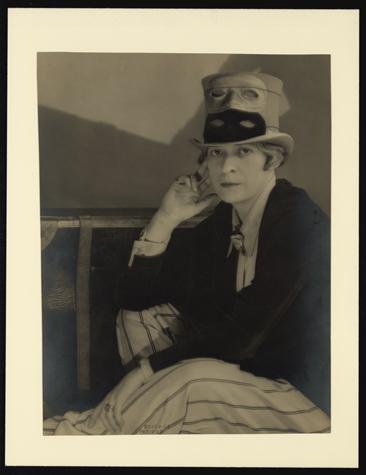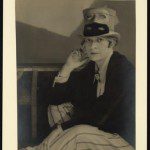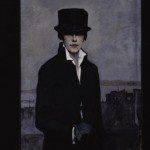Pity the National Portrait Gallery and its director Martin Sullivan.
Weeks after mounting the astoundingly comprehensive, direct and illuminating exhibition “Hide/Seek: Difference and Desire in American Portraiture,” both the Gallery and Sullivan got cuffed and buffeted from every direction, proving again that no good deed goes unpunished.
“Hide/Seek” is a good deed, although you’d get some in-your-face debate on that from the Catholic League and House Republican leaders John Boehner and Eric Canto.
The exhibition is a good deed, not in any do-gooder, mealy-mouthed way, but because it is a very good exhibition. Secondly, it took a certain amount of courage to even go forward with the project, especially in the National Portrait Gallery, which isn’t exactly the headquarters for portraits of outsider cultures in America. There is a Hall of Presidents here, but not a Hall of prominent LGBT men and women.
“Hide/Seek” seeks to create a portrait, general and specific, through over 100 paintings, sculptures, photographs and videos, of gay and lesbian culture in America—its iconography, its artists, its style of life both hidden and open. In that sense, it’s a history piece, and it serves comprehensively to fulfill what’s mostly missing in the Gallery: portraits of culturally and artistically prominent gay men and women in America—even if the exhibition is not permanent.
Not only that, but as the title indicates, the exhibition is concerned with how gay men and women managed to articulate their tastes and desires to others in a society which shunned, closeted and punished, legally and otherwise, those differences and desires.
It’s a hefty subject, a hefty title, complicated, subtle and broad at once. Walt Whitman, the literary sage of gay eroticism is here, recognized by the moderns as a kind of rambunctious, but also deflective prophet. Gertrude Stein, Langston Hughes, Anthony Tudor, Carl Van Vechten, Janet Flanner, Marsden Hartley, Djuna Barnes Frank O’Hara, James Baldwin, Jasper Johns and Robert Mapplethorpe, in one form or another, are all significant to gay cultural history. And let’s add Andy Warhol, his self-portrait(s), and his painting of Truman Capote’s shoe.
But the canvas is much broader: a series of photographs in which two men walk on opposite sides of a sidewalk, pass each other, turn around, or men’s clothing advertising, or blues lyrics from Bessie Smith. This is an exhibition not only about notables, but about gay desire in many of its aspects. I would suspect if you had an exhibition made up purely of portraits of famous, notable gay men and women, artists, actors, and so on, nobody would bat an eye. But add the process, the life, the loves, the courtships. Add the word desire, and, well, you’re in trouble. Gay sexuality is precisely the thing that straight people don’t want to deal with, the thing that engenders all the clichés, the horrible jokes, the fears in the military, the secrets held within. They say the heart knows its mind, but so does desire, and both are insistent.
How do you hide in plain sight?
Through fashion, design, self-portraits, by creating great works of art. The exhibition, so varied, so full of riches, is an eye-opener to many, I’m sure, myself included. But it is also rich in terrific paintings, photography and stories.
It warrants more than one visit. Robert Mapplethorpe’s self-portrait, for instance, shows him as his own best subject, never mind the bad sex photos that made for big audiences.
For the Portrait Gallery, this was the third exhibition, each different, each not quite the usual fare in recent months. This is not meant to compare, but the ‘One Life’ exhibition on Post Publisher Katharine Graham, Al Wertheimer’s dramatic portrait of Elvis Presley in 1956, and now “Hide/Seek,” should be a triumphant triptych.
So what happened? For weeks, nothing, until Catholic League president William Donahue discovered a single, four-minute video by the late David Wojnarowicz, which included 11 seconds showing ants crawling over the Crucifix. Donahue called it “hate speech.” Outrage ensued. Boehner, the presumptive Speaker of the House, and whip Eric Cantor lashed out dire warnings and expressions about taxpayers money and the American people. “American families have a right to expect better from recipients of taxpayers’ funds in a tough economy,” Boehner said. There was talking of pressure to close the show itself.
Sullivan in response issued a statement that included, in part: “I regret that some reports about the exhibit have created an impression that the video is intentionally sacrilegious. In fact, the artist’s intention was to depict the suffering of an AIDS victim. It was not the museum’s intention to offend. We have removed the video. I encourage people to visit the exhibition online or in the building.”
More outrage, this time from artists and art critics, some of whom sound like the high priests of DC art, smacking Sullivan for “caving in,” insisting that it was censorship. Small demonstrations erupted and the video was moved to a gallery near Logan Circle. Everybody talked and wrote in maximalist, scorched-earth terms.
We wouldn’t support censorship of any kind either. But I think it’s a little unfair to shower blame on the museum director when the real blame lies with the politicians and religious leaders who want to have the power to censor in the name of the American people. The GOP leaders especially can now say for sure they control the purse strings—not by the way for exhibitions, which are financed by private or corporate sponsors, but for the operations and salaries paid to museum employees.
Nobody is going to fire a critic for insisting on the holiness of artistic expression, even if it is less than holy or downright awful. Easy for us to say.
As it was, Sullivan returned the attention to where it really belongs: to a very fine, fascinating exhibition. Like the man said, go visit the website or the building.
“Hide/Seek” will be at the National Portrait Gallery through February 13, 2011. For more information, visit www.npg.si.edu
- Jordan Wright




